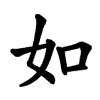Definify.com
Definition 2025
毋
毋
Translingual
| Stroke order | |||
|---|---|---|---|

| |||
Han character
毋 (radical 80 毋+0, 4 strokes, cangjie input 田十 (WJ), four-corner 77500)
- do not
- not
- A surname.
- Kangxi radical #80, ⽏ (“do not”).
References
- KangXi: page 588, character 23
- Dai Kanwa Jiten: character 16721
- Dae Jaweon: page 980, character 29
- Hanyu Da Zidian: volume 4, page 2380, character 1
- Unihan data for U+6BCB
Chinese
|
simp. and trad. |
毋 | |
|---|---|---|
Alternative forms
Pronunciation
Note: This character is used as a substitute for Min Nan m̄, which may be etymologically unrelated.
- Mandarin
- (Standard Chinese, Beijing)+
- Pinyin:
- Zhuyin: ㄨˊ
- Wade-Giles: wu2
- Gwoyeu Romatzyh: wu
- IPA (key): /u³⁵/
- (Standard Chinese, Beijing)+
- Cantonese
- (Standard Cantonese, Guangzhou)+
- Jyutping: mou4
- Yale: mòuh
- Cantonese Pinyin: mou4
- IPA (key): /mou̯²¹/
- (Standard Cantonese, Guangzhou)+
- Hakka
- (Sixian, incl. Miaoli and Meinong)
- Pha̍k-fa-sṳ: mù / m̀
- Hakka Romanization System: muˇ / mˇ
- Hagfa Pinyim: mu2 / m2
- IPA: /mu¹¹/, /m¹¹/
- (Sixian, incl. Miaoli and Meinong)
- Min Nan
- (Hokkien)
- Pe̍h-ōe-jī: m̄
- Tâi-lô: m̄
- Phofsit Daibuun: m
- IPA (Xiamen): /m̩²²/
- IPA (Quanzhou): /m̩⁴¹/
- IPA (Zhangzhou): /m̩²²/
- IPA (Taipei): /m̩³³/
- IPA (Kaohsiung): /m̩³³/
- (Hokkien)
| Rime | |
|---|---|
| Character | 毋 |
| Reading # | 1/1 |
| Initial (聲) | 明 (4) |
| Final (韻) | 虞 (24) |
| Tone (調) | Level (Ø) |
| Openness (開合) | Closed |
| Division (等) | III |
| Fanqie | 武夫切 |
| Reconstructions | |
| Zhengzhang Shangfang |
/mɨo/ |
| Pan Wuyun |
/mio/ |
| Shao Rongfen |
/mio/ |
| Edwin Pulleyblank |
/muə̆/ |
| Li Rong |
/mio/ |
| Wang Li |
/mĭu/ |
| Bernard Karlgren |
/mi̯u/ |
| Expected Mandarin Reflex |
wú |
| Baxter-Sagart system 1.1 (2014) | |
|---|---|
| Character | 毋 |
| Reading # | 1/1 |
| Modern Beijing (Pinyin) |
wú |
| Middle Chinese |
‹ mju › |
| Old Chinese |
/*mo/ |
| English | don"t |
Notes for Old Chinese notations in the Baxter-Sagart system: * Parentheses "()" indicate uncertain presence; | |
| Zhengzhang system (2003) | |
|---|---|
| Character | 毋 |
| Reading # | 1/1 |
| No. | 9301 |
| Phonetic component |
母 |
| Rime group |
魚 |
| Rime subdivision |
0 |
| Corresponding MC rime |
無 |
| Old Chinese |
/*ma/ |
| Notes | 母轉註字 |
Definitions
毋
- (Min Nan) not
- 我毋捌字。 [Min Nan] ― Góa m̄ pat-jī. [Pe̍h-ōe-jī] ― I'm illterate (literally: I don't know characters)
- (Classical Chinese) do not
References
- (Min Nan) “Entry #818”, in 臺灣閩南語常用詞辭典 [Dictionary of Frequently-Used Taiwan Minnan] (in Chinese and Min Nan), Ministry of Education, R.O.C., 2011.
Japanese
Kanji
- This term needs a translation to English. Please help out and add a translation, then remove the text
{{rfdef}}.
Readings
Usage notes
Not used in Japanese shinjitai in isolation – instead the unsimplified 母 is used – but simplified form is used universally in compound jōyō characters, such as 毎, 海.
However, not used in hyōgaiji, which are written in kyūjitai, such as 姆.
Korean
Hanja
毋 • (mu) (hangeul 무, revised mu, McCune-Reischauer mu, Yale mu)
- This term needs a translation to English. Please help out and add a translation, then remove the text
{{rfdef}}.
Vietnamese
Han character
毋 (vô)
- This term needs a translation to English. Please help out and add a translation, then remove the text
{{rfdef}}.


